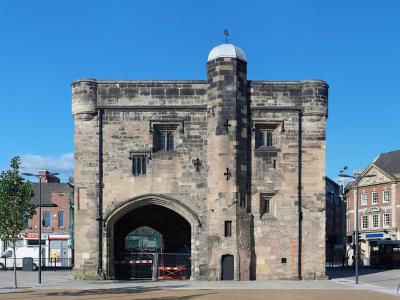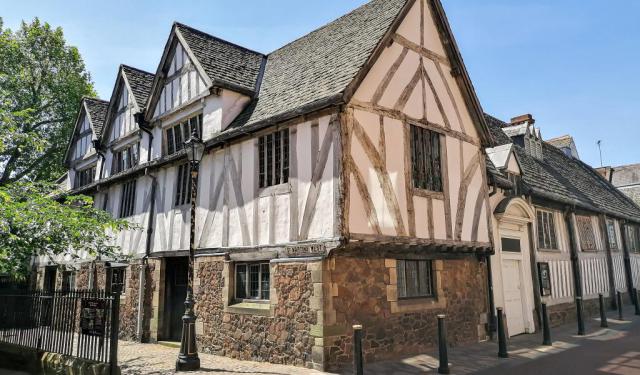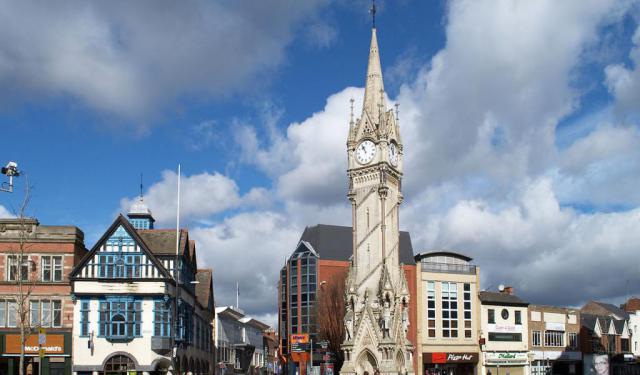
Magazine Gateway, Leicester
The Magazine Gateway, built in 1410, is one of Leicester’s most notable landmarks. Originally, it served as a ceremonial entrance to the Castle of Leicester, though it never had doors. Designed to impress visitors, it also provided access to the prestigious Newark District—a sought-after residential area where inhabitants were exempt from taxes.
The gateway’s primary function was to create a grand entrance into the religious collegiate precinct of The Newarke. This area had been significantly developed in the 14th century. In 1330, Henry, the 3rd Earl of Lancaster, founded Trinity Hospital along the castle’s southern wall. His son, later the Duke of Lancaster, further elevated the district’s status by establishing the Collegiate Church of the Annunciation of St. Mary, which housed a revered relic—said to be a thorn from Christ’s Crown of Thorns.
Constructed shortly after 1400, the Gateway was completed alongside substantial walls enclosing the college precinct. By 1967, however, the James Went Building had been constructed over part of the site, and photographs suggest that some sections of the medieval walls remained standing at heights of up to 3 meters (9.8 feet) until that time.
The 1960s inner ring road development left the Magazine Gateway isolated, with major roads running on both sides and only accessible via pedestrian underpasses. In 1969, it was repurposed as a museum for the Royal Leicestershire Regiment, a role it fulfilled until 1996. Repairs and limited accessibility within the three-story structure eventually led to the museum’s relocation to the upper floor of the Newarke Houses Museum.
By 2007, efforts were made to better integrate this Grade I listed medieval building into the urban landscape. The underpass was filled in, allowing the street level on the west side to align with the gateway. The road was rerouted entirely to the east, and the western area was pedestrianized, reconnecting the Gateway with The Newarke. This transformation also created a new open space for students of De Montfort University, near its Business and Law School.
The gateway’s primary function was to create a grand entrance into the religious collegiate precinct of The Newarke. This area had been significantly developed in the 14th century. In 1330, Henry, the 3rd Earl of Lancaster, founded Trinity Hospital along the castle’s southern wall. His son, later the Duke of Lancaster, further elevated the district’s status by establishing the Collegiate Church of the Annunciation of St. Mary, which housed a revered relic—said to be a thorn from Christ’s Crown of Thorns.
Constructed shortly after 1400, the Gateway was completed alongside substantial walls enclosing the college precinct. By 1967, however, the James Went Building had been constructed over part of the site, and photographs suggest that some sections of the medieval walls remained standing at heights of up to 3 meters (9.8 feet) until that time.
The 1960s inner ring road development left the Magazine Gateway isolated, with major roads running on both sides and only accessible via pedestrian underpasses. In 1969, it was repurposed as a museum for the Royal Leicestershire Regiment, a role it fulfilled until 1996. Repairs and limited accessibility within the three-story structure eventually led to the museum’s relocation to the upper floor of the Newarke Houses Museum.
By 2007, efforts were made to better integrate this Grade I listed medieval building into the urban landscape. The underpass was filled in, allowing the street level on the west side to align with the gateway. The road was rerouted entirely to the east, and the western area was pedestrianized, reconnecting the Gateway with The Newarke. This transformation also created a new open space for students of De Montfort University, near its Business and Law School.
Want to visit this sight? Check out these Self-Guided Walking Tours in Leicester. Alternatively, you can download the mobile app "GPSmyCity: Walks in 1K+ Cities" from Apple App Store or Google Play Store. The app turns your mobile device to a personal tour guide and it works offline, so no data plan is needed when traveling abroad.
Magazine Gateway on Map
Sight Name: Magazine Gateway
Sight Location: Leicester, England (See walking tours in Leicester)
Sight Type: Attraction/Landmark
Guide(s) Containing This Sight:
Sight Location: Leicester, England (See walking tours in Leicester)
Sight Type: Attraction/Landmark
Guide(s) Containing This Sight:
Walking Tours in Leicester, England
Create Your Own Walk in Leicester
Creating your own self-guided walk in Leicester is easy and fun. Choose the city attractions that you want to see and a walk route map will be created just for you. You can even set your hotel as the start point of the walk.
Historical Buildings
Leicester, a city in England's East Midlands, has a storied past that is vividly presented in its historical buildings. Valuable architectural monuments, they are the city's pride and as such enjoy special protection by the government.
Among such, Magazine Gateway stands as a testament to the city's medieval legacy. Originally part of its defensive walls, this structure now... view more
Tour Duration: 2 Hour(s)
Travel Distance: 2.6 Km or 1.6 Miles
Among such, Magazine Gateway stands as a testament to the city's medieval legacy. Originally part of its defensive walls, this structure now... view more
Tour Duration: 2 Hour(s)
Travel Distance: 2.6 Km or 1.6 Miles
Leicester Introduction Walking Tour
Leicester is one of the oldest cities in England, whose history goes back almost two millennia. The Romans arrived in the area around 47 AD, during their conquest of southern Britain. Following the Saxon invasion, Leicester was then captured by Danish Vikings, in the 9th century.
The settlement was first documented in the early 10th century, under the name Ligeraceaster. At the time of the... view more
Tour Duration: 1 Hour(s)
Travel Distance: 1.1 Km or 0.7 Miles
The settlement was first documented in the early 10th century, under the name Ligeraceaster. At the time of the... view more
Tour Duration: 1 Hour(s)
Travel Distance: 1.1 Km or 0.7 Miles


